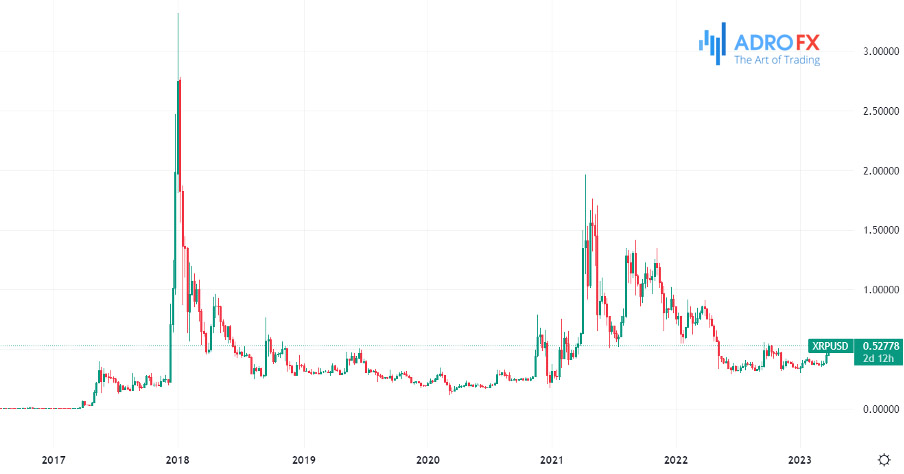Is XRP (Ripple) A Buy Under $3? A Detailed Investment Analysis

Table of Contents
Ripple's Technology and Use Cases
Ripple's success hinges on its innovative technology and real-world applications. Understanding these is crucial to assessing whether XRP is a worthwhile investment under $3.
Understanding the XRP Ledger (XRPL)
The XRP Ledger (XRPL) is a distributed, open-source, permissionless ledger designed for speed, scalability, and low transaction costs. Unlike many blockchains that rely on energy-intensive mining, XRPL uses a unique consensus mechanism, making it significantly more energy-efficient.
- Exceptional Speed: XRPL boasts significantly faster transaction speeds compared to many other cryptocurrencies, processing transactions in a matter of seconds.
- Scalability and Efficiency: Its architecture allows for high transaction throughput, making it suitable for large-scale applications. The low energy consumption contributes to its cost-effectiveness.
- Programmability: The XRPL supports smart contracts and decentralized applications (dApps), expanding its potential use cases beyond simple payments.
Real-World Applications of XRP
RippleNet, Ripple's payment network, utilizes XRP to facilitate fast and low-cost cross-border transactions for financial institutions. This is a significant differentiator for XRP in the cryptocurrency market.
- Key Partnerships: Ripple has partnered with numerous major banks and financial institutions globally, including Santander, Bank of America, and many others, demonstrating significant real-world adoption.
- Successful Use Cases: These partnerships have resulted in successful implementations of XRP for cross-border payments, showcasing its practical utility in the financial sector. Examples include faster remittance services and reduced transaction costs for international money transfers.
Competitive Landscape
XRP faces competition from other cryptocurrencies in the payment space, but its unique features offer potential advantages.
- XRP vs. Other Payment Cryptocurrencies: While competitors like Stellar Lumens (XLM) also focus on cross-border payments, XRP benefits from its established partnerships and broader adoption within the financial industry. However, regulatory uncertainty presents a challenge.
- Strengths and Weaknesses: XRP's strengths lie in its speed, efficiency, and established partnerships. However, its dependence on Ripple's central authority and regulatory scrutiny remain potential weaknesses.
XRP Price Analysis and Prediction
Analyzing XRP's past performance and current market conditions is crucial for predicting its future price trajectory.
Historical Price Performance
XRP's price has seen significant volatility. It reached an all-time high in 2018, followed by a substantial correction. Analyzing historical charts reveals periods of substantial growth and decline, influenced by factors such as regulatory news and market sentiment.
- Key Price Movements: Tracking these historical movements helps identify potential support and resistance levels, offering insights into future price action. However, past performance is not indicative of future results.
Technical Analysis
Technical indicators provide insights into potential future price movements.
- Moving Averages: Analyzing moving averages (e.g., 50-day and 200-day) can signal potential trend reversals or confirmations of existing trends.
- RSI (Relative Strength Index): The RSI helps identify overbought or oversold conditions, potentially indicating short-term price reversals.
- Support and Resistance Levels: Identifying historical support and resistance levels can help predict price boundaries.
Disclaimer: Technical analysis is not foolproof and should be used in conjunction with fundamental analysis.
Fundamental Analysis
Fundamental analysis considers factors beyond price charts. Ripple's partnerships, regulatory landscape, and overall market adoption significantly impact XRP's value.
- Ripple's Financials and Partnerships: The financial health of Ripple and its strategic partnerships influence investor confidence and XRP's price.
- Regulatory Landscape: Regulatory clarity or uncertainty around cryptocurrencies, especially in key markets, significantly impacts XRP's price.
- Market Adoption: Widespread adoption of XRP by financial institutions and businesses strengthens its value proposition.
Risk Assessment and Investment Strategy
Investing in XRP, like any cryptocurrency, involves significant risk. A well-defined strategy is crucial.
Volatility and Risk Factors
Cryptocurrency markets are inherently volatile. Investing in XRP exposes you to significant price fluctuations.
- Price Crashes: The cryptocurrency market is prone to sudden and dramatic price drops.
- Regulatory Uncertainty: Changes in regulatory frameworks can significantly impact XRP's price and accessibility.
- Market Sentiment: Investor sentiment heavily influences cryptocurrency prices.
Diversification and Portfolio Allocation
Diversification is key to mitigating risk. Don't invest more than you can afford to lose.
- Risk Tolerance: Allocate a percentage of your investment portfolio to XRP based on your risk tolerance. A conservative approach might allocate a smaller percentage.
- Diversified Portfolio: Spread your investments across different asset classes to reduce overall portfolio volatility.
Buy, Hold, or Sell?
Based on the analysis, whether XRP is a buy under $3 depends on your risk tolerance and investment horizon. The potential for growth exists, driven by Ripple's technology and partnerships, but the inherent volatility and regulatory uncertainty cannot be ignored.
- Pros: Potential for significant price appreciation, real-world applications, and established partnerships.
- Cons: High volatility, regulatory uncertainty, and competition from other cryptocurrencies.
A balanced approach might involve accumulating XRP gradually over time, rather than investing a large sum at once. Consider dollar-cost averaging to reduce the impact of volatility.
Conclusion: Is XRP (Ripple) a Buy Under $3? A Final Verdict
This analysis explored the potential of XRP as an investment under $3. While its innovative technology and real-world applications offer compelling arguments, the inherent volatility and regulatory uncertainty demand caution. The decision to buy, hold, or sell XRP ultimately depends on your individual risk tolerance and investment goals. Remember, conducting thorough due diligence before making any investment decisions is crucial. While this analysis provides valuable insights into whether XRP is a buy under $3, remember to conduct thorough due diligence before investing in any cryptocurrency. The information presented here is not financial advice. Learn more about XRP and its potential and make an informed decision about whether XRP (Ripple) is a suitable addition to your investment portfolio.

Featured Posts
-
 Actor Michael Sheens 100 000 Donation Erases 1 Million In Debt
May 02, 2025
Actor Michael Sheens 100 000 Donation Erases 1 Million In Debt
May 02, 2025 -
 Tulsas Growing Homeless Population A Frontline Report From The Tulsa Day Center
May 02, 2025
Tulsas Growing Homeless Population A Frontline Report From The Tulsa Day Center
May 02, 2025 -
 Six Nations Rugby France Reigns Supreme Englands Victory Scotland And Ireland Struggle
May 02, 2025
Six Nations Rugby France Reigns Supreme Englands Victory Scotland And Ireland Struggle
May 02, 2025 -
 Actors And Writers Strike What It Means For Hollywoods Future
May 02, 2025
Actors And Writers Strike What It Means For Hollywoods Future
May 02, 2025 -
 Fortnite Down Checking Server Status For Update 34 21
May 02, 2025
Fortnite Down Checking Server Status For Update 34 21
May 02, 2025
